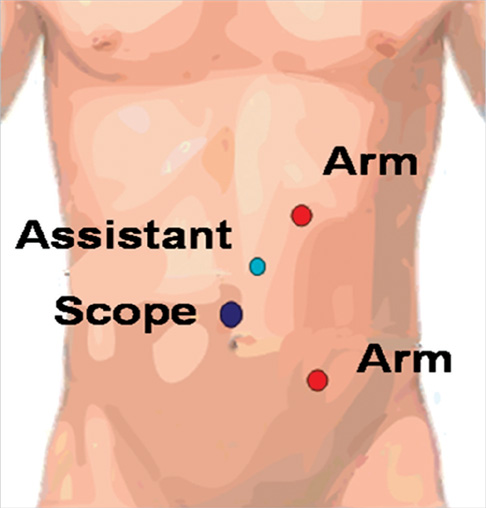J Korean Med Sci.
2011 Jan;26(1):150-153. 10.3346/jkms.2011.26.1.150.
Robot-assisted Resection of Paraspinal Schwannoma
- Affiliations
-
- 1Spine and Spinal Cord Research Institute, Department of Neurosurgery, Yonsei University College of Medicine, Seoul, Korea. hayoon@yuhs.ac
- KMID: 1777992
- DOI: http://doi.org/10.3346/jkms.2011.26.1.150
Abstract
- Resection of retroperitoneal tumors is usually perfomed using the anterior retroperitoneal approach. Our report presents an innovative method utilizing a robotic surgical system. A 50-yr-old male patient visited our hospital due to a known paravertebral mass. Magnetic resonance imaging showed a well-encapsulated mass slightly abutting the abdominal aorta and left psoas muscle at the L4-L5 level. The tumor seemed to be originated from the prevertebral sympathetic plexus or lumbosacral trunk and contained traversing vessels around the tumor capsule. A full-time robotic transperitoneal tumor resection was performed. Three trocars were used for the robotic camera and working arms. The da Vinci Surgical System(R) provided delicate dissection in the small space and the tumor was completely removed without damage to the surrounding organs and great vessels. This case demonstrates the feasibility of robotic resection in retroperitoneal space. Robotic surgery offered less invasiveness in contrast to conventional open surgery.
Keyword
MeSH Terms
Figure
Reference
-
1. Mathews HH, Evans MT, Molligan HJ, Long BH. Laparoscopic discectomy with anterior lumbar interbody fusion: a preliminary review. Spine (Phila Pa 1976). 1995. 20:1797–1802.2. Inamasu J, Guiot BH. Laparoscopic anterior lumbar interbody fusion: a review of outcome studies. Minim Invasive Neurosurg. 2005. 48:340–347.3. Kaiser MG, Haid RW Jr, Subach BR, Miller JS, Smith CD, Rodts GE Jr. Comparison of the mini-open versus laparoscopic approach for anterior lumbar interbody fusion: a retrospective review. Neurosurgery. 2002. 51:97–103.4. Zdeblick TA, David SM. A prospective comparison of surgical approach for anterior L4-L5 fusion: laparoscopic versus mini anterior lumbar interbody fusion. Spine (Phila Pa 1976). 2000. 25:2682–2687.5. Chung SK, Lee SH, Lim SR. Comparative study of laparascopic L5-S1 fusion versus open mini-anterior lumbar interbody fusion. J Korean Neurosurg Soc. 2003. 33:154–159.6. Ballantyne GH. Robotic surgery, telerobotic surgery, telepresence, and telementoring. Surg Endosc. 2002. 16:1389–1402.7. Moorthy K, Munz Y, Dosis A, Hernandez J, Martin S, Bello F, Rockall T, Darzi A. Dexterity enhancement with robotic surgery. Surg Endosc. 2004. 18:790–795.8. Rha KH. The present and future of robotic surgery. J Korean Med Assoc. 2008. 51:67–73.9. Moskowitz RM, Young JL, Box GN, Paré LS, Clayman RV. Retroperitoneal transdiaphragmatic robotic-assisted laparoscopic resection of a left thoracolumbar neurofibroma. JSLS. 2009. 13:64–68.10. Morgan JA, Kohmoto T, Smith CR, Oz MC, Argenziano M. Endoscopic computer-enhanced mediastinal mass resection using robotic technology. Heart Surg Forum. 2003. 6:E164–E166.11. Ruurda JP, Hanlo PW, Hennipman A, Broeders IA. Robot-assisted thoracoscopic resection of a benign mediastinal neurogenic tumor: technical note. Neurosurgery. 2003. 52:462–464.12. Kim MJ, Ha Y, Yang MS, Yoon DH, Kim KN, Kim H, Yang JW, Lee JY, Yi S, Jung WJ, Rha KH. Robot-assisted anterior lumbar interbody fusion (ALIF) using retroperitoneal approach. Acta Neurochir (Wien). 2010. 152:675–679.13. Lanfranco AR, Castellanos AE, Desai JP, Meyers WC. Robotic surgery: a current perspective. Ann Surg. 2004. 239:14–21.14. Mack MJ. Minimally invasive and robotic surgery. JAMA. 2001. 285:568–572.15. Harada K, Nishizaki T, Adachi N, Suzuki M, Ito H. Pediatric acoustic schwannoma showing rapid regrowth with high proliferative activity. Childs Nerv Syst. 2000. 16:134–137.16. Hwang SK, Kim DG, Paek SH, Kim CY, Kim MK, Chi JG, Jung HW. Aggressive vestibular schwannomas with postoperative rapid growth: clinicopathological analysis of 15 cases. Neurosurgery. 2002. 51:1381–1390.17. Seol HJ, Jung HW, Park SH, Hwang SK, Kim DG, Paek SH, Chung YS, Lee CS. Aggressive vestibular schwannomas showing postoperative rapid growth-their association with decreased p27 expression. J Neurooncol. 2005. 75:203–207.18. Ohta S, Yokoyama T, Nishizawa S. Massive haemorrhage into acoustic neurinoma related to rapid growth of the tumour. Br J Neurosurg. 1998. 12:455–457.19. Maniar HS, Council ML, Prasad SM, Prasad SM, Chu C, Damiano RJ Jr. Comparison of skill training with robotic systems and traditional endoscopy: implications on training and adoption. J Surg Res. 2005. 125:23–29.
- Full Text Links
- Actions
-
Cited
- CITED
-
- Close
- Share
- Similar articles
-
- Comparative analysis of robot-assisted vs. open abdominoperineal resection in terms of operative and initial oncological outcomes
- Paraspinal Ancient Schwannoma of the Dorsal Ramus Nerve: A Case Report
- A Review of Robot-Assisted Gait Training in Stroke Patients
- Short-term surgical outcomes of robot-assisted colectomy for colon cancer using the hinotori Surgical Robot System
- Large Paraspinal Schwannoma Removal via the Retroperitoneal Approach: A Case Report




